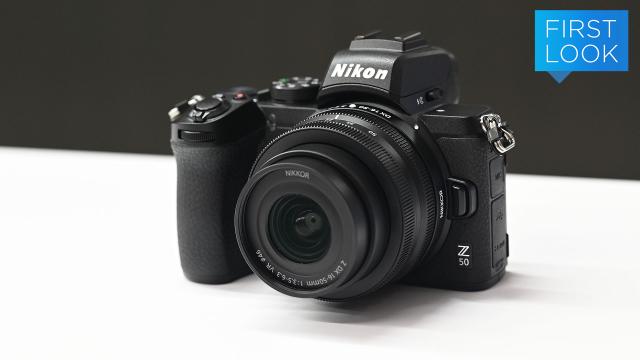After launching the Z6 and Z7 last year, the next thing people wanted to know is how Nikon planned to expand its new family of mirrorless cameras so that more people could buy them. Because while the Z6 and Z7 are great cameras, they’cost around $3,000 and $5,000 respectively, which isn’t really what you’d call affordable. The Z50 is here to answer that question.
In contrast to Canon’s approach to creating the more affordable but still full-frame EOS-RP mirroless camera, Nikon opted to go with the same scheme it’s used with its DSLR cameras. Instead of a full-frame sensor, the has Z50 a 20.9-MP DX sensor (which is more commonly called APS-C outside of Nikon land).
So while the Z50’s image quality might not be quite as good as what you get from the Z6/Z7, its smaller sensor allows for a much more compact body. The Z50 weighs in at 400g, compared to the 675g Nikon Z6.
Both the Z50 and the Z6/Z7 feature Nikon’s Z-mount, which means all three cameras can use the same set of interchangeable lenses Nikon has been rolling out since its Z-series launch last fall.
Despite its smaller dimensions, the Z50 still has a solid design including a magnesium-alloy frame and a sizable grip that makes it easy to hold. That said, the Z50 doesn’t have the same level of rain and weather resistance of its full-frame siblings. (Nikon says the Z50’s water resistance is closer to what you get on the D5600.)
Furthermore, because of its light weight, Nikon added some handy features that should make the Z50 more attractive to vloggers and other mobile photo/video fans. The Z50 the first Z-series camera to have a built-in pop-up flash, and its rear 3.2-inch touchscreen can also be flipped 180-degrees downward, so you can use it to check your framing and composition when you’re filming yourself.
Nikon even claims it’s designed a special tripod that can take the place of Joby’s ubiquitous GorillaPod without blocking the screen, though I haven’t had a chance to check it out yet.
Other top-line specs include continuous shooting at up to 11 fps, 209 phase-detect autofocus points with Nikon’s Eye-Detection AF, and 4K UHD video recording at up to 30 FPS (along with a 120 FPS slow-mo mode). The Z50 also sports a mic in jack for better audio recording, although you don’t get a dedicated headphone out jack like you do on the Z6/Z7.
The Z50 also comes with a timelapse mode that can merge photos in the camera, along with 20 creative filters that you can see in real-time for both stills and video. Unfortunately, while I did get a chance to handle the new Z50, I wasn’t able to take any photo samples, so we’ll have to wait a bit longer to see how the Z50’s photos look.
But the best thing about the Z50 might be its price. The Z50 is available in one of two kits: a $1,799.95 kit that includes a Nikkor Z DX 16-50mm f/3.5-6.3 lens, or a $2,099.95 kit with the 16-50mm lens and a Nikkor DX Z 50-250mm f/4.5-6.3 lens. The Nikon Z50 will be available starting in November.
Finally, for anyone who has been waiting for the super high-end 58mm f/0.95 Noct lens Nikon announced last year, Nikon announced that it will be available on October 31 for a staggering $US8,000 ($11,830).
Editor’s Note: Australian pricing and availability is yet to be confirmed.
Designed as the ultimate low-light lens for tasks like astrophotography, Nikon claims its new Noct lens is the fastest, sharpest lens the company has ever made. It’s manual focus only, supports 5-axis image stabilisation, and comes with a built-in focus assist button and an onboard display.
